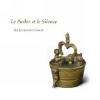Texte paru dans: / Appeared in:

Fanfare Magazine: 37:3 (01-02/2014)
Pour
s'abonner / Subscription information
Les abonnés à Fanfare Magazine ont accès aux archives du
magazine sur internet.
Subscribers to Fanfare Magazine have access to the archives of the magazine
on the net.
Ramée
1206

4250128512060 (ID343)
Consultez toutes les évaluations recensées pour ce cd
~~~~ Reach all the evaluations located for this CD
The Attaignant Consort wisely refrains from explaining what they mean by “Speaking and Silence.” Is it the music that speaks, the notes preceded and followed by silence? The tradition of polyphony that would shortly give way to the primacy of homophonic music? The fantasias and arrangements of vocal works, soon to give way to more thoroughly structured works composed for winds? The Renaissance and Baroque flutes (heard here in instrumental families styled after 16th and 18th century models) that would be stilled with the advent of newer models? Regardless, the Attaignant Consort supplies a fascinating program to illustrate the subtitle of their latest release.
As with their earlier albums, Le Parler et le Silence follows the modern practice in many live performances of forming discrete groups of selections that espouse some form of common identity along with internal and external contrasts. An example is the three Sweelinck arrangements—two witty bicinia or teaching pieces, each in two parts, based on French texts, followed by a learned but sweet five-part setting of Psalm 9. These three pieces, with their high order of imitative art, in turn lead into a section of five English works, the break of continuity illustrated by leading off with an arrangement of Francis Pilkington’s strictly homophonic madrigal My choice is made. The English pieces are in fact a microcosm of secular Elizabethan English music media, presenting madrigals, lute songs, and consort fantasias with variations in diminution. Each succeeding section in turn reveals careful attention to programming for formal diversity and central ideas, whether by nation, individual composer, or (as the program ends with a sonata da chiesa by Boismortier) increasingly formalized structure. In short, this isn’t one of those albums that sports an undifferentiated-four-recorders-as-one sound, but a program of diverse origins, thoughtfully explored by anywhere from solo instruments to full ensemble.
The Attaignant Consort appears not to have been reviewed in these pages, before. It was formed in 1998. Three out of four of their original members are still in the group. While recorder consorts aren’t exactly rare, this ensemble brings both a textural variety and touch of class to everything they do. Lutenist Nigel North’s eloquent performances contribute to the former; unpressured tone and sculpted phrasing, to the latter. The engineering is reasonably dry, close and balanced, with the lute never getting lost behind the Attaignants. Highly recommended.
Cliquez l'un ou l'autre
bouton pour découvrir bien d'autres critiques de CD
Click either button for many other reviews


